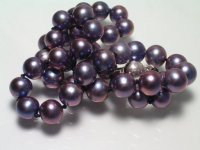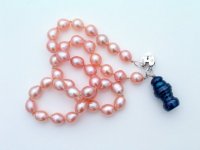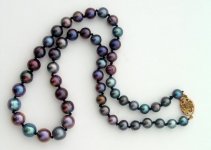Hi Dfrey, The dyes used in the stones are different and a lot would rub off from alcohol. However, for pearls, they probably keep on doing research on dye improvement to keep the luster of the pearls and the orient even when dyed...but I haven't tried 99% alcohol though...
-----------------------
Don't know if it's ok to quote below... mods, please delete if it violates anything.
From: Handbook of Gem Identification, Richard T. Liddicoat, Jr.
Detection of Artificial Color in Black Pearls. Page 128
...black dye can be detected by rubbing it with a white swab soaked in a weak solution (1:20) of nitric acid; the swab will be slightly discolored. Other pearls however, are treated in a manner that attackes conchiolin and turns it black, and acid swabs will not detect it. Still others are soaked in silver salt solution, such as silver nitrate, and exposed to light precipitate free silver. These show white streaks on the x-ray (silver is opaque to x-rays).
Naturally colored black pearls usually fluoresce pink to red under long-wave ultraviolet light; treated blacks either fail to fluoresce, or have a whitish fluorescence. A few natural blacks fail to fluoresce, but these are distinguished by the presence of green, rod-like inclusions in a near transparent surface layer. Otherwise, a failure to fluorescer in a reddish color is satisfactory evidence of artificial color.
Acid and Solvents. Page 164-165
Acids, particularly dilute hydrochloric acid, is very useful in testing, serving a variety of purposes. For example, any of the carbonates such as calcite (which, when dyed, is used to imitate jade - the so-called Mexican jade), coral, shell, pearl, smithsonite, malachite, and rhodochrosite are revealed by pronounced effervescence when a drop of dilute hydrocholic acid is placed on the surface. On malachite and azurite, which are copper carbonates, the spot turns yellow-green.
Caution: Since hydrochloric acid attackes the surface of any carbonate quickly and strongly, it should be wiped off after the slightest touch and the spot quickly washed with water.
...Cultured and natural pearls are dyed black by various methods, some of which leave a surface stain detectable with acid-dipped swab. For this test, a swab dipped in a dilute solution (1:20) of nitric acid and rubbed against a pearls shows a faint dark stain, revealing the dyed surface.




